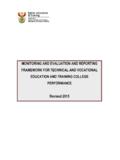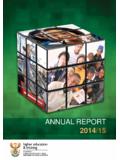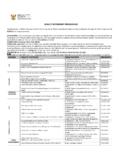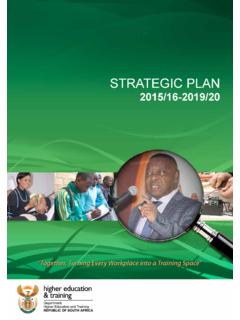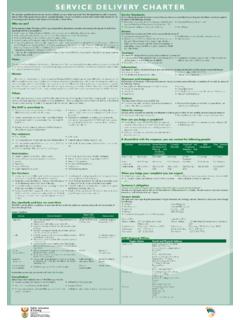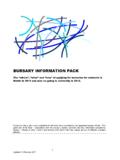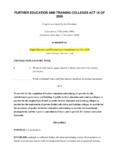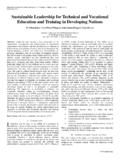Transcription of RULES AND GUIDELINES FOR THE ADMINISTRATION AND …
1 RULES AND GUIDELINES FOR THE ADMINISTRATION AND MANAGEMENT OF THE DEPARTMENT OF HIGHER education AND training TECHNICAL AND vocational education AND training college BURSARY SCHEME FOR 2017 Opening the doors of learning is as important today as it was when the Freedom Charter was written . Dr Blade Nzimande, Minister of Higher education and training (Green Paper on Post-School education and training ) 2 TABLE OF CONTENTS 1. Purpose .. 4 2. Policy and Legal Context .. 4 3. Bursary Funds Allocation Criteria to Colleges .. 6 4. Student Eligibility Criteria for the DHET TVET college Bursary Scheme .. 7 5. Minimum Required Documentation .. 7 6. Exemption from Paying Registration Fees.
2 9 7. Bursary ADMINISTRATION Process .. 9 8. Bursary ADMINISTRATION Schedule .. 10 9. Role of the Financial Aid and Appeals Committees .. 11 10. Criteria for Awarding Bursaries to Students .. 13 11. Awarding of Travel and Accommodation Allowances .. 17 12. Disbursement of Travel and Accommodation Allowances .. 20 13. Verification of Residential Addresses of the Recipients of Allowances .. 21 14. Additional NSFAS and college Responsibilities .. 21 15. Monitoring and Support .. 22 16. Marketing .. 22 TEMPLATES A Checklist for bursary B Letter to Successful C Letter to Unsuccessful D Bursary ADMINISTRATION Monitoring E Bursary ADMINISTRATION Annual Work 3 ACRONYMS DG: Director-General DDG: Deputy-Director General DHET: Department of Higher education and training FAC: Financial Aid Committee FAL: First Additional Language FAO: Financial Aid Officer FTE: Full time equivalent ID: Identity Document NC(V): National Certificate ( vocational ) NQF: National Qualifications Framework NSC: National Senior Certificate NSDS III: National Skills Development Strategy III NSFAS: National Student Financial Aid Scheme NSF-TVET Colleges.
3 National Norms and Standards for Funding Technical and vocational education and training Colleges PDE: Provincial Departments of education Report 191: National education Policy, formal Technical Colleges Instructional Programmes in the RSA SASSA South African Social Security Agency SoP: Schedule of Particulars (Agreement between NSFAS and a student) SRC: Student Representative Council SSS: Student Support Services TVET: Technical and vocational education and training Umalusi: Council for Quality Assurance in General and Further education and training VCET: vocational and Continuing education and training 4 PURPOSE The purpose of this document is to provide the National Student Financial Aid Scheme (NSFAS) and Technical and vocational education and training (TVET) colleges with the RULES and GUIDELINES for the ADMINISTRATION , management, and awarding of bursaries to qualifying students.
4 POLICY AND LEGAL CONTEXT These RULES and GUIDELINES have been developed in accordance with the 2008 National Norms and Standards for Funding Further education and training Colleges (NSF-FET Colleges) . In terms of the Continuing education and training Act, 2006, the Minister of Higher education and training must determine policy on the norms and standards for funding TVET Colleges. To this effect, in 2009, the Minister promulgated the National Norms and Standards for funding FET Colleges, hereafter referred to as the NSF-TVET Colleges . Due to the name change from FET to TVET ( Technical and vocational education and training ) the Norms and Standards for Funding FET Colleges are now referred to as the NSF-TVET Colleges.
5 1. In terms of the NSF-TVET Colleges, each student enrolled in a state-funded programme must be subsidised by the state at 80% of the total programme cost. The difference of 20% of the total programme costs, which constitute college fees, must be recovered from the student. 2. In order to ensure that college fees do not constitute a barrier to access to state-funded programmes, paragraph 73 of the NSF-TVET Colleges, and paragraph of the National Plan for Further education and training Colleges in South Africa, 2008; state that the Government shall establish and maintain a national TVET college bursary system and the ADMINISTRATION of this bursary scheme will be by NSFAS.
6 This is to ensure that academically deserving and yet financially needy students gain access to education and training opportunities in TVET Colleges. The bursary amount covers the 20% portion of student fees for academically deserving and financially needy students. 3. Paragraph 73 of the NSF-TVET Colleges and paragraph of the National Plan for Further education and training Colleges in South Africa, 2008 further require the Department to develop RULES and GUIDELINES for the ADMINISTRATION and management of the TVET college Bursary Scheme. This document must therefore be understood against this policy injunction. 5 4. To gain a comprehensive understanding of the legal and the policy framework that underpins the TVET college Bursary Scheme, these RULES and GUIDELINES must be read in conjunction with: National Student Financial Aid Scheme Act, 1999 (as amended); Continuing education and training Act, 2006 (as amended); The National Plan for Further education and training Colleges in South Africa, 2008; National Norms and Standards for Funding Further education and training Colleges, 2009; The extension of phasing out of the National N Certificates: N1 N3 (Engineering Studies), Government Gazette No.
7 33793; The extension of the offering of National N Certificates: N4 N6, Government Gazette No. 33794; Approval of the policy document Formal TVET college programmes at Levels 2 to 4 of the NQF, Government Gazette No. 33795; Report of the Ministerial Committee on the Review of the National Student Financial Aid Scheme; DHET TVET college Student Attendance and Punctuality Policy, 2013; NSFAS GUIDELINES and Regulations, as codified within the NSFAS Student Funding Policy and the NSFAS Handbook; and DHET Bursary ADMINISTRATION Improvement Manual, 2013. 5. Pursuant to the commitment made in the policy and legislation cited above, in 2007, for the first time in the history of TVET Colleges, a bursary scheme was introduced as a means to improve access to priority vocational programmes offered at TVET Colleges.
8 6. The provision of student financial aid is critical for enabling access to TVET Colleges. The role of TVET Colleges as the nucleus of skills development in South Africa is explicitly contained in the National Skills Development Strategy (NSDS) III published in January 2011 by Minister Nzimande. The challenge of access to post-school education and training opportunities for academically deserving students but financially needy students is addressed by the bursary scheme. 7. The permissible bursary awards are updated annually. Refer to paragraph 38 below for amounts for travel and accommodation as well as the programme costs of the 2017 academic 6 year.
9 Programme costs for the following year will be sent separately to Colleges before the end of September of each year. BURSARY FUNDS ALLOCATION CRITERIA TO COLLEGES 8. The Department allocates bursary funds to Colleges on an annual basis taking the following into consideration: Programme costs in accordance with the NSF-TVET Colleges; DHET approved actual National Certificate ( vocational ) (NC(V)) and Report 191 enrolments; Students academic performance and retention rates in NC(V) and Report 191 programmes; college fees; and Available funding. 9. Accurate and fair distribution of the bursary funds is of paramount importance. These principles are applied to the Full Time Equivalent (FTE) enrolment figures finalised by the end of February of each year.
10 Paragraph 13 of the NSF-TVET Colleges outlines the following as three key components of the funding formula: The first component is the government subsidy which covers 80% of the programme costs; The second component is placing a cap on college level fees, thus limiting the portion of programme cost which may be charged to 20% of the programme cost; and The third and last component is the establishment of a national bursary scheme to ensure that students who are academically capable but financially needy are assisted to cover their college fees. 10. Taking into account the components of the funding formula, the National Student Financial Aid Scheme (NSFAS) and Colleges must first and foremost prioritise the awarding of college fees to qualifying students.
